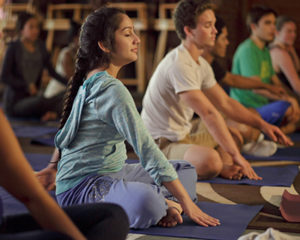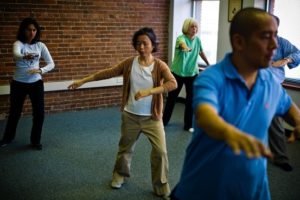Improve Well-Being and Psychological Flexibility with Mindfulness Practice
By John M. de Castro, Ph.D.
“There are an endless variety of ways to meditate and practice mindfulness. . . specific types of mindfulness-meditation seem to have specific benefits. Fine-tuning which type of mindfulness or meditation someone uses as a prescriptive to treat a specific need will most likely be the next big advance in the public health revolution of mindfulness and meditation.” – Christopher Bergland
Mindfulness training has been shown to be effective in improving physical and psychological health and particularly with the physical and psychological reactions to stress. Techniques such as Mindfulness Training, Mindfulness-Based Stress Reduction (MBSR) and Mindfulness-Based Cognitive Therapy (MBCT) as well as Yoga practice and Tai Chi or Qigong practice have been demonstrated to be effective. This has led to an increasing adoption of these mindfulness techniques for the health and well-being of both healthy and ill individuals.
Mindfulness practice, however, is a complex involving formal and informal practices, and great differences in the frequency and duration of practice. It is not known which of these facets or which combinations of facets are responsible for the beneficial effects of mindfulness. In addition, learning and implementing mindfulness practices can be difficult with a number of impediments and problems present. Hence there is a need to investigate the characteristics of mindfulness practices and the impediments to and supports for practicing mindfulness and their relationship to the well-being and psychological flexibility of the participants.
In today’s Research News article “An Exploration of Formal and Informal Mindfulness Practice and Associations with Wellbeing.” (See summary below or view the full text of the study at: https://www.ncbi.nlm.nih.gov/pmc/articles/PMC6320743/ ), Birtwell and colleagues recruited mindfulness practitioners and had them complete a questionnaire on their mindfulness practice, difficulties encountered with practice, and factors that supported their practice. They also completed scales measuring mental well-being and psychological flexibility.
They found 37% of the participants learned mindfulness practice through a formal course while the rest learned on their own through books, the internet, or through therapists. Most practiced several times per week or daily for 10 to 45 minutes. 57% of the participants indicated that falling asleep during practice was an impediment to practice and many indicated that finding time to practice was a problem. In support of their practice they reported that it was helpful to set up particular times for practice, to practice with others in groups, and having an accepting and kind attitude toward themselves, particularly during lapses in practice.
Correlating practice factors with mental well being and psychological flexibility they found that the greater the frequency and duration of formal and informal practice the greater the levels of mental well-being and psychological flexibility. But, when all of the practice factors were considered they found that the frequency of informal practice was the only one that significantly predicted improved mental well-being and psychological flexibility.
Informal practices involved everyday mindful moments such as being mindful while engaged in everyday activities such as “washing the dishes, eating, driving, brushing teeth, walking the dog, drinking coffee, and watching a wild bird or flower.” Hence, it would appear that integrating mindfulness into everyday life is essential for mindfulness to be associated with good mental well-being and psychological flexibility. In other words, feeling psychologically better and being able to approach psychological issues with acceptance and flexibly is best supported by engaging in daily activities mindfully.
It needs to be kept in mind that these findings are correlational and conclusions regarding causation cannot be reached. It is possible that people who are flexible and have mental well-being are those who engage in informal practices or some other factor may be responsible for both. There is a need for future manipulative research to determine causation.
So, improve well-being and psychological flexibility with mindfulness practice.
“Daily meditation is a powerful tool for managing your stress and enhancing your health. But bringing present-moment awareness to all your daily activities is important.” Melissa Young
CMCS – Center for Mindfulness and Contemplative Studies
This and other Contemplative Studies posts are also available on Google+ https://plus.google.com/106784388191201299496/posts and on Twitter @MindfulResearch
Study Summary
Birtwell, K., Williams, K., van Marwijk, H., Armitage, C. J., & Sheffield, D. (2018). An Exploration of Formal and Informal Mindfulness Practice and Associations with Wellbeing. Mindfulness, 10(1), 89-99.
Abstract
Mindfulness has transdiagnostic applicability, but little is known about how people first begin to practice mindfulness and what sustains practice in the long term. The aim of the present research was to explore the experiences of a large sample of people practicing mindfulness, including difficulties with practice and associations between formal and informal mindfulness practice and wellbeing. In this cross-sectional study, 218 participants who were practicing mindfulness or had practiced in the past completed an online survey about how they first began to practice mindfulness, difficulties and supportive factors for continuing to practice, current wellbeing, and psychological flexibility. Participants had practiced mindfulness from under a year up to 43 years. There was no significant difference in the frequency of formal mindfulness practice between those who had attended a face-to-face taught course and those who had not. Common difficulties included finding time to practice formally and falling asleep during formal practice. Content analysis revealed “practical resources,” “time/routine,” “support from others,” and “attitudes and beliefs,” which were supportive factors for maintaining mindfulness practice. Informal mindfulness practice was related to positive wellbeing and psychological flexibility. Frequency (but not duration) of formal mindfulness practice was associated with positive wellbeing; however, neither frequency nor duration of formal mindfulness practice was significantly associated with psychological flexibility. Mindfulness teachers will be able to use the present findings to further support their students by reminding them of the benefits as well as normalising some of the challenges of mindfulness practice including falling asleep.
https://www.ncbi.nlm.nih.gov/pmc/articles/PMC6320743/








